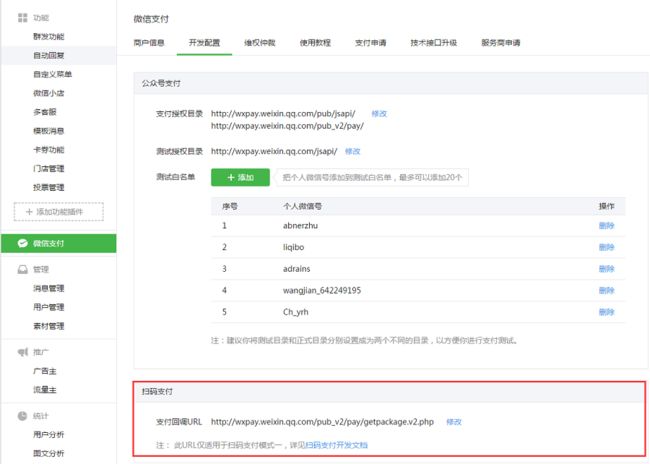此项目已开源欢迎Start、PR、发起Issues一起讨论交流共同进步
https://github.com/Javen205/IJPay
http://git.oschina.net/javen205/IJPay
微信极速开发系列文章:http://www.jianshu.com/p/a172a1b69fdd
上一篇文章介绍了微信提供的那些支付方式以及公众号支付http://www.jianshu.com/p/cb2456a2d7a7
这篇文章我们来聊聊微信扫码支付(模式一以及模式二)
先奉上研究微信扫码支付踩过的坑
微信扫码支付文档
扫码支付官方文档
###### 扫码支付分为以下两种方式:
【模式一】:商户后台系统根据微信支付规则链接生成二维码,链接中带固定参数productid(可定义为产品标识或订单号)。用户扫码后,微信支付系统将productid和用户唯一标识(openid)回调商户后台系统(需要设置支付回调URL),商户后台系统根据productid生成支付交易,最后微信支付系统发起用户支付流程。
【模式二】:商户后台系统调用微信支付统一下单API生成预付交易,将接口返回的链接生成二维码,用户扫码后输入密码完成支付交易。注意:该模式的预付单有效期为2小时,过期后无法支付。详细接入步
扫码支付模式一
1、设置支付回调URL
商户支付回调URL设置指引:进入公众平台-->微信支付-->开发配置-->扫码支付-->修改 如下图(来自官方文档)
在开源项目weixin-guide中
扫码支付模式一的回调URL为http://域名[/项目名称]/pay/wxpay
2、根据微信支付规则链接生成二维码
2.1 生成二维码规则
二维码中的内容为链接,形式为:
weixin://wxpay/bizpayurl?sign=XXXXX&appid=XXXXX&mch_id=XXXXX&product_id=XXXXXX&time_stamp=XXXXXX&nonce_str=XXXXX
详细的参数说明参考文档 点击这里
商户ID(mch_id)如何获取点击这里
签名安全规则文档 点击这里
在开源项目weixin-guide中
扫码支付模式一生成二维码规则封装如下:
public String getCodeUrl(){
String url="weixin://wxpay/bizpayurl?sign=XXXXX&appid=XXXXX&mch_id=XXXXX&product_id=XXXXX&time_stamp=XXXXX&nonce_str=XXXXX";
String product_id="001";
String timeStamp=Long.toString(System.currentTimeMillis() / 1000);
String nonceStr=Long.toString(System.currentTimeMillis());
Map packageParams = new HashMap();
packageParams.put("appid", appid);
packageParams.put("mch_id", partner);
packageParams.put("product_id",product_id);
packageParams.put("time_stamp", timeStamp);
packageParams.put("nonce_str", nonceStr);
String packageSign = PaymentKit.createSign(packageParams, paternerKey);
return StringUtils.replace(url, "XXXXX", packageSign,appid,partner,product_id,timeStamp,nonceStr);
} 以上action 在开源项目weixin-guide中 访问地址为http://域名[/项目名称]/pay/getCodeUrl 其中 product_id 根据实际的业务逻辑可以当做参数传入
2.2 生成二维码并在页面上显示
根据2.1生成二维码规则生成了二维码中的内容(链接)来生成二维码。
商户可调用第三方库生成二维码图片
这里使用google 开源图形码工具Zxing
项目中引入相关的jar包 具体配置参考项目中的pom.xml
3.2.1
com.google.zxing
core
${zxing.version}
com.google.zxing
javase
${zxing.version}
封装的工具类为com.javen.kit.ZxingKit
/**
* google 开源图形码工具Zxing使用
*/
public class ZxingKit {
private static Log log = Log.getLog(ZxingKit.class.getSimpleName());
/**
* Zxing图形码生成工具
*
* @param contents
* 内容
* @param barcodeFormat
* BarcodeFormat对象
* @param format
* 图片格式,可选[png,jpg,bmp]
* @param width
* 宽
* @param height
* 高
* @param margin
* 边框间距px
* @param saveImgFilePath
* 存储图片的完整位置,包含文件名
* @return
*/
public static Boolean encode(String contents, BarcodeFormat barcodeFormat, Integer margin,
ErrorCorrectionLevel errorLevel, String format, int width, int height, String saveImgFilePath) {
Boolean bool = false;
BufferedImage bufImg;
Map hints = new HashMap();
// 指定纠错等级
hints.put(EncodeHintType.ERROR_CORRECTION, errorLevel);
hints.put(EncodeHintType.MARGIN, margin);
hints.put(EncodeHintType.CHARACTER_SET, "UTF-8");
try {
// contents = new String(contents.getBytes("UTF-8"), "ISO-8859-1");
BitMatrix bitMatrix = new MultiFormatWriter().encode(contents, barcodeFormat, width, height, hints);
MatrixToImageConfig config = new MatrixToImageConfig(0xFF000001, 0xFFFFFFFF);
bufImg = MatrixToImageWriter.toBufferedImage(bitMatrix, config);
bool = writeToFile(bufImg, format, saveImgFilePath);
} catch (Exception e) {
e.printStackTrace();
}
return bool;
}
/**
* @param srcImgFilePath
* 要解码的图片地址
* @return
*/
@SuppressWarnings("finally")
public static Result decode(String srcImgFilePath) {
Result result = null;
BufferedImage image;
try {
File srcFile = new File(srcImgFilePath);
image = ImageIO.read(srcFile);
if (null != image) {
LuminanceSource source = new BufferedImageLuminanceSource(image);
BinaryBitmap bitmap = new BinaryBitmap(new HybridBinarizer(source));
Hashtable hints = new Hashtable();
hints.put(DecodeHintType.CHARACTER_SET, "UTF-8");
result = new MultiFormatReader().decode(bitmap, hints);
} else {
log.debug("Could not decode image.");
}
} catch (Exception e) {
e.printStackTrace();
} finally {
return result;
}
}
/**
* 将BufferedImage对象写入文件
*
* @param bufImg
* BufferedImage对象
* @param format
* 图片格式,可选[png,jpg,bmp]
* @param saveImgFilePath
* 存储图片的完整位置,包含文件名
* @return
*/
@SuppressWarnings("finally")
public static Boolean writeToFile(BufferedImage bufImg, String format, String saveImgFilePath) {
Boolean bool = false;
try {
bool = ImageIO.write(bufImg, format, new File(saveImgFilePath));
} catch (Exception e) {
e.printStackTrace();
} finally {
return bool;
}
}
public static void main(String[] args) {
String saveImgFilePath = "D://zxing.png";
Boolean encode = encode("我是Javen205", BarcodeFormat.QR_CODE, 3, ErrorCorrectionLevel.H, "png", 200, 200,
saveImgFilePath);
if (encode) {
Result result = decode(saveImgFilePath);
String text = result.getText();
System.out.println(text);
}
}
} OK 上面就是生成支付二维码的部分,接下来就是要将二维码显示在页面上,于是就有了下面的代码:com.javen.weixin.controller.WeixinPayController.getPayQRCode()
src\\main\\webapp\\view\\payQRCode.jsp
/**
* 生成支付二维码(模式一)并在页面上显示
*/
public void scanCode1(){
//获取扫码支付(模式一)url
String qrCodeUrl=getCodeUrl();
System.out.println(qrCodeUrl);
//生成二维码保存的路径
String name = "payQRCode.png";
Boolean encode = ZxingKit.encode(qrCodeUrl, BarcodeFormat.QR_CODE, 3, ErrorCorrectionLevel.H, "png", 200, 200,
PathKit.getWebRootPath()+File.separator+"view"+File.separator+name );
if (encode) {
//在页面上显示
setAttr("payQRCode", name);
render("payQRCode.jsp");
}
}JSP 部分代码如下

最终生成二维码访问地址为
http://域名[/项目名称]/pay/scanCode1
以上就是微信扫码支付(模式一)生成支付二维码的全过程
3、扫码回调商户支付URL
用户扫码后,微信支付系统将productid和用户唯一标识(openid)回调商户后台系统。
此回调的URL为上文
设置支付回调的URL。特别要注意的是返回参数是xml输入流
HttpServletRequest request = getRequest();
/**
* 获取用户扫描二维码后,微信返回的信息
*/
InputStream inStream = request.getInputStream();
ByteArrayOutputStream outSteam = new ByteArrayOutputStream();
byte[] buffer = new byte[1024];
int len = 0;
while ((len = inStream.read(buffer)) != -1) {
outSteam.write(buffer, 0, len);
}
outSteam.close();
inStream.close();
String result = new String(outSteam.toByteArray(),"utf-8");
System.out.println("callBack_xml>>>"+result);
4、根据回调参数生成预付订单进行支付
根据回调参数调用统一下单API生成预支付交易的prepay_id
prepay_xml>>>
商户后台系统将prepay_id返回给微信支付系统,微信支付系统根据交易会话标识,发起用户端授权支付流程。
/**
* 发送信息给微信服务器
*/
Map payResult = PaymentKit.xmlToMap(xmlResult);
String return_code = payResult.get("return_code");
String result_code = payResult.get("result_code");
if (StrKit.notBlank(return_code) && StrKit.notBlank(result_code) && return_code.equalsIgnoreCase("SUCCESS")&&result_code.equalsIgnoreCase("SUCCESS")) {
// 以下字段在return_code 和result_code都为SUCCESS的时候有返回
String prepay_id = payResult.get("prepay_id");
Map prepayParams = new HashMap();
prepayParams.put("return_code", "SUCCESS");
prepayParams.put("appId", appid);
prepayParams.put("mch_id", mch_id);
prepayParams.put("nonceStr", System.currentTimeMillis() + "");
prepayParams.put("prepay_id", prepay_id);
String prepaySign = null;
if (sign.equals(packageSign)) {
prepayParams.put("result_code", "SUCCESS");
}else {
prepayParams.put("result_code", "FAIL");
prepayParams.put("err_code_des", "订单失效"); //result_code为FAIL时,添加该键值对,value值是微信告诉客户的信息
}
prepaySign = PaymentKit.createSign(prepayParams, paternerKey);
prepayParams.put("sign", prepaySign);
String xml = PaymentKit.toXml(prepayParams);
log.error(xml);
renderText(xml);
} 5、支付结果通用通知
官方文档 点击这里
对后台通知交互时,如果微信收到商户的应答不是成功或超时,微信认为通知失败,微信会通过一定的策略定期重新发起通知,尽可能提高通知的成功率,但微信不保证通知最终能成功。 (通知频率为15/15/30/180/1800/1800/1800/1800/3600,单位:秒)
注意:同样的通知可能会多次发送给商户系统。商户系统必须能够正确处理重复的通知。
推荐的做法是,当收到通知进行处理时,首先检查对应业务数据的状态,判断该通知是否已经处理过,如果没有处理过再进行处理,如果处理过直接返回结果成功。在对业务数据进行状态检查和处理之前,要采用数据锁进行并发控制,以避免函数重入造成的数据混乱。
特别提醒:商户系统对于支付结果通知的内容一定要做签名验证,防止数据泄漏导致出现“假通知”,造成资金损失。
技术人员可登进微信商户后台扫描加入接口报警群。
此通知接收地址为生成预付订单时设置的notify_url 。在开源项目weixin-guide中通知默认的地址为http://域名[/项目名称]/pay/pay_notify
以上是微信扫码支付模式一的全过程。
扫码支付模式二
模式二与模式一相比,流程更为简单,不依赖设置的回调支付URL。商户后台系统先调用微信支付的统一下单接口,微信后台系统返回链接参数code_url,商户后台系统将code_url值生成二维码图片,用户使用微信客户端扫码后发起支付。注意:code_url有效期为2小时,过期后扫码不能再发起支付。
微信支付的统一下单接口具体实现上文也有提及到,如果还不是很清楚可以看 com.javen.weixin.controller.WeixinPayController中的scanCode2 以及官方文档介绍
以下是调用预付订单返回的xml
其中code_url 就是生成二维码的链接
String qrCodeUrl = result.get("code_url");
String name = "payQRCode1.png";
Boolean encode = ZxingKit.encode(qrCodeUrl, BarcodeFormat.QR_CODE, 3, ErrorCorrectionLevel.H, "png", 200, 200,
PathKit.getWebRootPath()+File.separator+"view"+File.separator+name );
if (encode) {
//在页面上显示
setAttr("payQRCode", name);
render("payQRCode.jsp");
}扫码即可进行支付,code_url有效期为2小时,过期后扫码不能再发起支付
最终生成二维码访问地址为
http://域名[/项目名称]/pay/scanCode2
码字完毕,以上就是微信扫码支付(模式一、模式二)的详细介绍。
欢迎留言、转发
微信极速开发系列文章:http://www.jianshu.com/p/a172a1b69fdd
后续更新预告
1、刷卡支付
2、微信红包
3、企业转账
